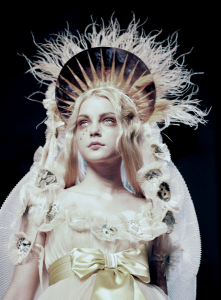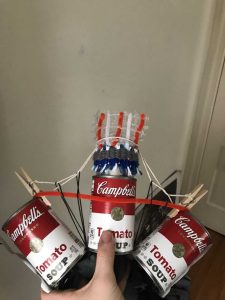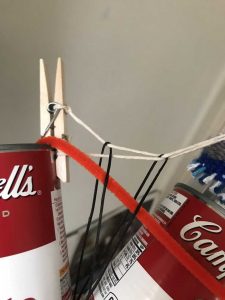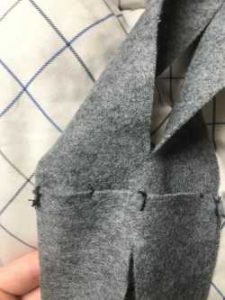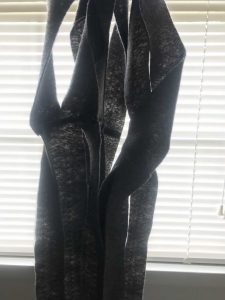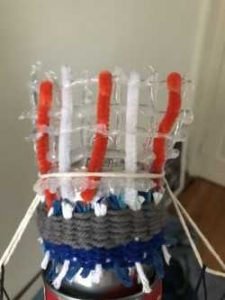Designing a physical garment that connected three disparate people was not the easiest task. How were we to create a garment that not only embodied ourselves but could function socially? Our group recognized what connects us socially is our undying love for art history. So, we set out to make an unconventional social garment that would function as art history: informing the public of our status as art history majors as well as visually constructing art history from the ancient to the contemporary. The group chose a form that could metaphorically hold the weight of disparate art histories as well as showcase how different fibrous forms could help portray those art histories: the headpiece.
Headpieces have a long art historical narrative. In antiquity, the heads of sculptures were often exaggerated to represent wisdom and power. Roman soldiers were given a laurel or crown to signify bravery in battle. Later, in the Renaissance, headpieces were associated with divine powers. These historical references were manipulated in the 2007 John Paul Gaultier Couture Collection, which featured models wearing headdresses that communicated religiosity. Excitedly, we immediately realized the headdress would be the best garment form to raise consciousness about art history because of its attention-grabbing location on the top of the head and because of its embodiment of Classical and Renaissance art traditions.
While the base was indeed inspired by earlier traditions, we did not want the only art historical reference to be the garment’s shape. We wanted the headpiece to represent an amalgam of our art historical interests: decorative arts for Hampton, architectural features for Melissa, and contemporary references for Taylor. The opportunity to blend disparate art historical styles enabled us to comment on dyadic issues in art history: the distinction between ancient and modern, high and low, handmade and mechanical, minimal and maximal. The desire to create a semi-cohesive piece that embodied each of our periods of interest as well as the dialectics of art history drove both the processes of material collection and of making.
The materials and processes used to make the headpiece needed to embody art historical references while simultaneously synthesizing these references, thus we consulted an eclectic group of materials. Beyond cost-efficiency, the group hunted for materials (especially fabric, cloth, and fibers) that conveyed a wide variety of textures, patterns, and colors. We quickly realized the base had to be sturdy, yet flexible, if we wanted to actually wear the headpiece. Using mere ribbon to build, connect, and tie the piece together would have disabled us to form the volume desired on the headdress. Thus, we needed a structure – in this case, a plastic headband and three soup cans – that would support the other parts of the headdress. The flexible black ribbon, while not a great fiber for holding things together, was used to materially mask the plasticity of the headband: blurring the lines between the handmade and the machine. Furthermore, the sheets of felt (9 x 12’) that hang down like hair from the base were cut in half, and hand-stitched together, short end to short end. Inspired by Robert Morris, each felt panel was cut and/or twisted in a specific way to convey the material’s ability to respond to gravity and movement in its own unique way.
Once the base was finished, we began to weave the piece together. We began by placing a slender dasani can with a pop-tab inside of the central soup can. Noting the triangular construction of the cans, we decided to emphasize Melissa’s interest in classical architecture by weaving together the soup cans into a structure inspired by Roman aqueducts and vaults in classical temples from antiquity. Upon realizing it would be nearly impossible to cut a hole in the cans with the limited tools we had, we decided to place clothespins on the innermost edges of the two outer soup cans, enabling us to create a warp with the loose, cream-colored twine running through the pop-tab of the dasani can and parts of the clothespins. Once the basic structure was created, black twine was wrapped around the base of the headband twice,on either side, and was pulled tightly to create tension. The pipe cleaners were then weaved through the black wax twine and duct taped on the inside of the two outside soup cans.
While the piece certainly represented a wide swath of art historical references already, Hampton decided it was not gaudy enough. To truly emphasize the decorative, Hampton created an “textile” from hot glue. Like all challenges, this one had several attempts; however, we managed to make a warp base with the glue by applying glue to a smooth surface. After cooling, the glue warp was slowly peeled off. Pipe cleaners were then added as the weft. While different from the felt or the small woven pattern in class, the method of making was the same. Indeed, in a certain a sense, the object’s logic relies in the fact it is the story of art history told across different materials all made with the repeated action of creating a warp and weaving the weft.
Ultimately, this project redefined how fabric functions. Our group set out to create a functional object that easily informs the public of our status as art history majors while simultaneously blurring definitive dyads of art historical periods, style, and material. Each fiber used in the piece – the Morris-like felt, the aqueduct-inspired twine, and the decorative glue matrix – relied upon a similar structure: the warp and the weft. Each material reiteration spoke to a different period of art history, yet each remains connected. While each part of the headpiece claims a different function, ultimately they come together to create a cohesive headpiece that represents each team member individually.
